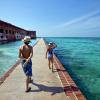By David A. Brown
No boat? Don’t like to get your feet wet?
No worries — it's time for you to learn how to how to pier fish. Florida’s central east coast offers several easily accessed fishing piers and jetties that bring anglers close to the deeper and more productive coastal waters along beaches and inlets. Add to that the briny breezes, melodic wave action and frequent dolphin sightings, and these scenic angling venues deliver a bounty of ambient appeal with a comfortable convenience that allows you to come and go as you please and learn how to pier fish in Florida.
These are our top Florida pier fishing tips to get you started on your angling adventure.
Choosing Favorable Tides
Piers like those at Daytona Beach, Cocoa Beach and Jupiter Inlet, along with pedestrian-friendly jetties at Ponce, Sebastian and Fort Pierce inlets, can produce just about any time, but consider the effects of lunar-driven tidal cycles. First, incoming tides signal increasing action as roaming predators such as mackerel, kingfish, tarpon, cobia, bluefish and sharks follow the baitfish schools that ride the rising water closer to these structures.
Jetties see another spike in activity when outgoing tides flush through the inlets and pull a buffet of baitfish and crustaceans from the backwaters.
Strong incoming or outgoing water will also influence which side (or end) of a pier or jetty you can fish to avoid tangling, while the mid-stages (aka “slack tides”) allow you to fish directly under the pier or right next to the jetty rocks — a challenging task during active tide stages. Fish are typically less aggressive when the current dwindles, but the greater precision of targeted presentations will often rattle someone’s cage enough to stimulate a bite.
Florida Pier Fishing Tips
For casual duties, when you're just learning how to pier fish, a double dropper rig with No. 2 hooks and a 2- to 6-ounce pyramid weight at the bottom will yield a mixed bag of pompano, whiting, redfish, black drum, flounder, bluefish and trout. Available in most tackle shops, double droppers are easy to tie and customizable with various colored beads and floats to hold the baited hooks above the bottom. Common baits for the smaller species include live shrimp, squid, sand fleas and clam strips (brined for toughness).
When you’re ready for a stronger challenge, fish cut sardines, whiting or mullet, or live baitfish (pinfish, pilchards) on a fish-finder rig (available at bait shops). Free-lining live baits also works, but make sure your free-swimmer does not tangle neighboring lines.
Pier and jetty anglers do well with medium to medium-heavy spinning outfits and 12- to 30-pound line, depending on their targeted species. The same 7- to 7½-foot combos common to inshore fishing will suffice, but for longer casts to deeper water, bump up to an 8- to 10-foot rod.
When prepping for your fishing mission, consider how far you'll have to walk and pack accordingly. Hand-pulled carts facilitate the transportation while centralizing your gear. Designs range from grocery baskets fitted with PVC rod holders to fully customized wheeled platforms with bait tank, cooler and gear racks. Then again, there’s nothing wrong with a single rod, a pocket full of spare tackle and a bucket of shrimp.
That's the beauty of fishing piers and jetties — you can go at your own pace, fish as long as you like and instantly shift gears to sightseeing mode whenever you feel like taking in the view. Taking the time to enjoy the scenery is one of the most important Florida pier fishing tips to remember.























